The Bay Trail Preview: Intel Atom Z3770 Tested
by Anand Lal Shimpi & Brian Klug on September 11, 2013 12:00 PM EST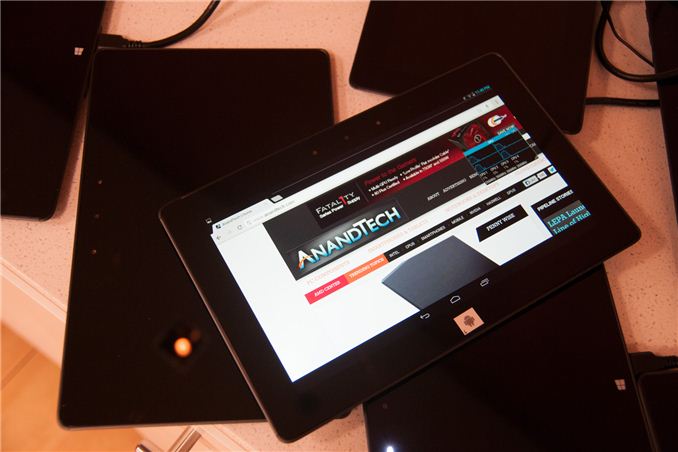
Earlier this year Intel unveiled Silvermont, its first true architectural update to Atom since its introduction in 2008. I won’t rehash Silvermont’s architecture here, but it’s designed to be a true test of Intel’s performance in the ultra mobile space. Leveraging Intel’s first 22nm SoC process and a very low power/efficient microarchitecture, Silvermont aims squarely at the latest Krait cores from Qualcomm and ARM’s Cortex A15.
Today Intel takes the next step forward, introducing the first tablet SoC based on Silvermont: Bay Trail.
Bay Trail takes up to four Silvermont cores, and for the first time in an ultra mobile Intel SoC pairs them with Intel’s own graphics IP. That’s right, rather than using a GPU block from Imagination Technologies, Bay Trail leverages the same GPU architecture as Ivy Bridge.
The first Bay Trail tablets will be shipping by the end of the year, across both Android and Windows 8.1. Intel expects Bay Trail to show up in tablets and 2-in-1s priced below $599, with everything above $599 falling under Haswell’s jurisdiction.
Bay Trail & Branding
Bay Trail, like all Atom platforms before it, will be available in multiple form factors. Unlike the Atoms of yesterday however, the SoC will carry Pentium and Celeron branding when used in notebooks and desktops. Intel didn’t disclose too much about its Silvermont plans in other form factors other than some basic naming:
Basically notebooks ship under the Pentium N3000 & Celeron N2000 series, while desktops will carry Pentium J2000 & Celeron J1000 branding. All Pentium SKUs seem to be quad-core, while Celeron SKUs will be available in both dual and quad-core versions.
Thankfully Intel shied away from introducing the same complexity with its tablet focused Bay Trail parts. All Bay Trail tablet SKUs carry Atom branding. There’s the quad-core Z3700 series and the dual-core Z3600 series.
Although Intel offers both dual and quad-core Bay Trail SKUs, they are both based on the same single physical design. In other words, dual-core Bay Trail parts are just die harvested quad-core parts. Intel isn’t disclosing die size or transistor counts, which is ironic (and disappointing) given that Apple just disclosed both (or at least relative magnitude of one) for its A7 SoC.
Internally, the Bay Trail design is pretty nice. There are either two or four cores enabled, each pair with a shared 1MB L2 cache (2MB total for a quad-core part). Intel is following the unfortunate lead of everyone else in the mobile industry and advertising max turbo frequencies exclusively.
Thankfully Intel hasn’t yet decided to obfuscate max non-turbo frequencies:
| Bay Trail Turbo Speeds | ||||||||
| Z3770 | Z3770D | Z3740 | Z3740D | Z3680 | Z3680D | |||
| Max turbo frequency | 2.39GHz | 2.41GHz | 1.86GHz | 1.83GHz | 2.0GHz | 2.0GHz | ||
| Max non-turbo Frequency | 1.46GHz | 1.5GHz | 1.33GHz | 1.33GHz | 1.33GHz | 1.33GHz | ||
In general you’re looking at 1.33GHz - 1.46GHz max non-turbo frequencies, with Bay Trail being able to turbo up to anywhere between 1.83GHz and 2.40GHz depending on SKU.
Although the core architecture is 64-bit in design, there will be no OS support for 64-bit Bay Trail at launch. Windows 8.1 with Connected Standby appears to still be 32-bit only, and obviously Android is 32-bit only at this point as well.
The memory interface is fairly ridiculous by mobile standards. You either get two 64-bit LPDDR3 channels (128-bit total width) or a single 64-bit DDR3L channel. In the case of the former, that’s the same memory bus width as Apple’s A5X/A6X line of SoCs as well as the standard Core i3/i5/i7 parts. Max supported memory frequency is 1066MHz in dual-channel LPDDR3 mode, or 1333MHz in single-channel DDR3L mode. The only benefit to the latter is really cost, as Bay Trail will purportedly show up in some very cheap devices.
The GPU is Intel’s own Gen7 graphics core, a cut down implementation of what we first saw in Ivy Bridge. I suppose it’s premature to expect Merrifield, Bay Trail’s smartphone counterpart, to also use Intel’s own graphics core but it’s clear this is the direction Intel is headed in - and away from licensing IP from Imagination Technologies.
Rather than 16 EUs in the Ivy Bridge GT2 configuration (HD 4000), Bay Trail’s HD Graphics core ships with 4. The 4 EUs are otherwise effectively identical to what we found in Ivy Bridge. The GPU can dynamically scale frequency and share power between itself and the CPU cores. Minimum GPU frequency on Bay Trail is 311MHz and a max GPU frequency of 667MHz (or 688MHz for the DDR3L SKUs).
Intel is quick to point out that Bay Trail’s GPU supports DirectX 11 and OpenGL ES 3.0. Unfortunately this support list appears limited to Windows. Under Android, it’s unclear whether or not Bay Trail will ship with anything above OpenGL ES 2.0 support. The same goes for GPU accelerated Renderscript. Bay Trail supports up to 2560 x 1440 displays over eDP1.3/DP1.2, or 1080p over HDMI. Panel Self Refresh is also supported.
Video encode and decode blocks also shifted away from Imagination in Bay Trail. Both IP blocks are custom from Intel now. The ISP (Image Signal Processor) is from Silicon Hive (an Intel acquisition).


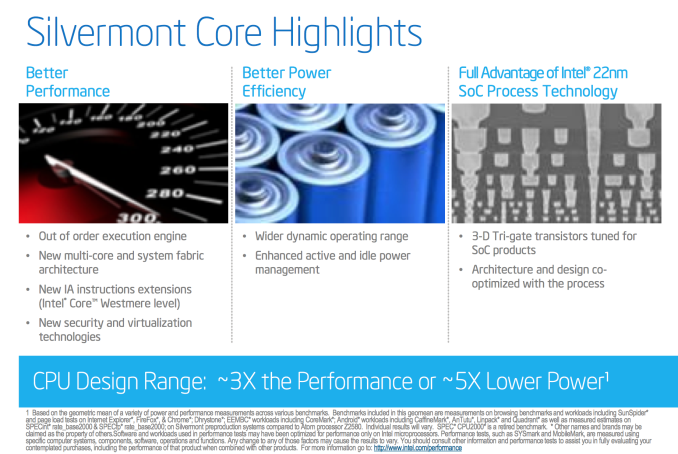
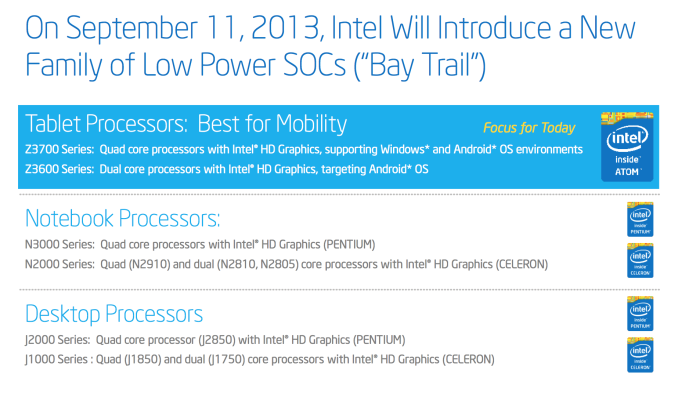
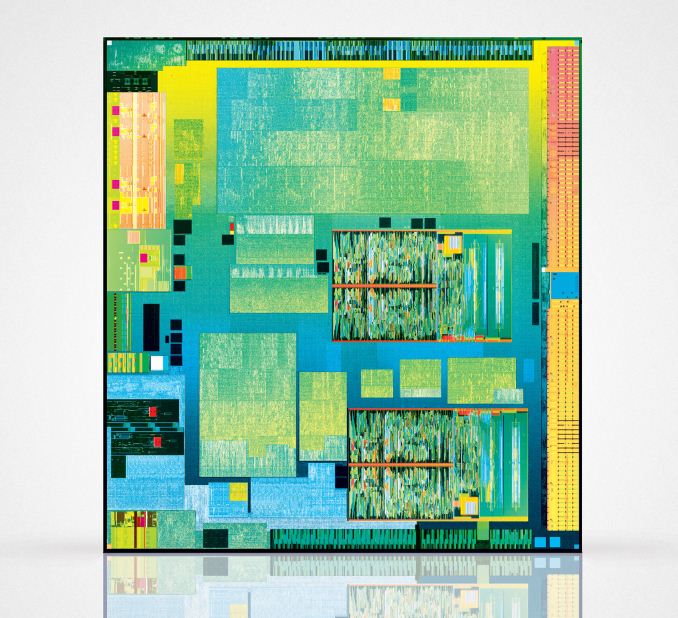
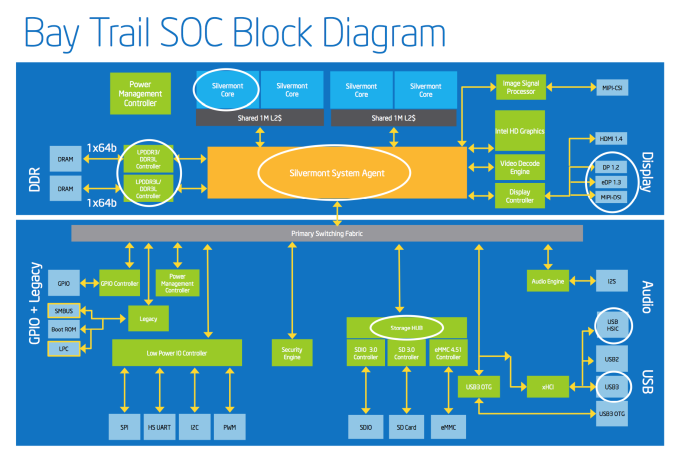
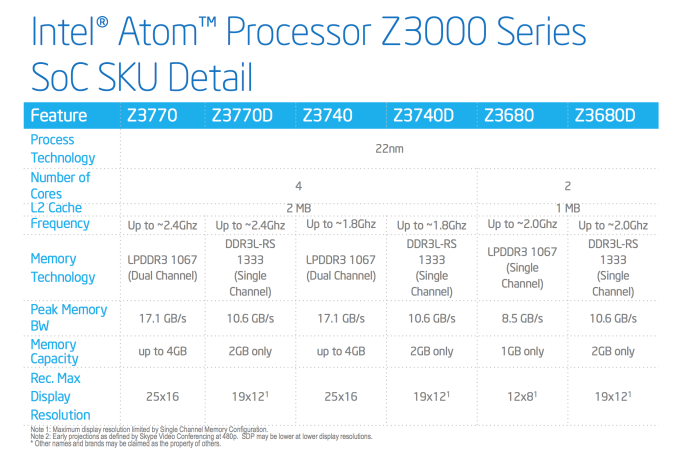
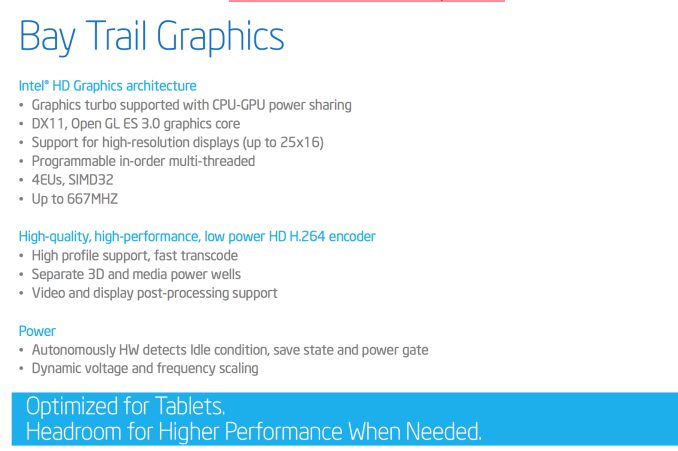
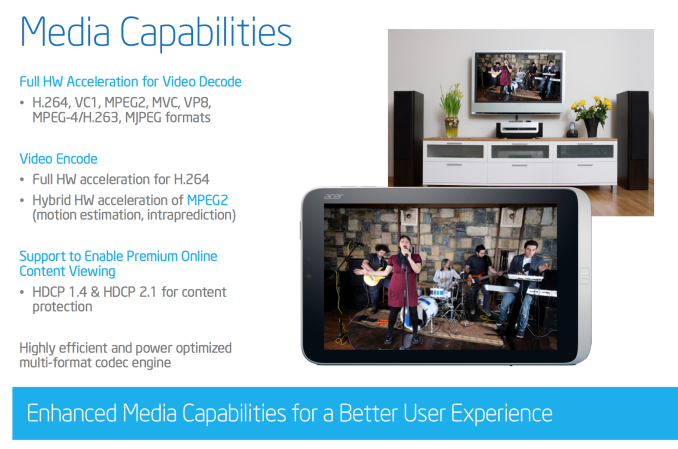








190 Comments
View All Comments
Speedfriend - Thursday, September 12, 2013 - link
"And on GPU, it concluded with " Intel's HD graphics in Bay Trail appear to be similar in performance to the PowerVR SGX 554MP4 in the iPad 4" I mean unless you are interpreting the results much more differently then what i read i the graph. Then please do explain yourself there. Because I dont read how it is "similar". There are like at least 20% of performance difference."In T-Rex offscreen, it equals the iPad4, so I would say he is correct, but off course T4 and Adreno 330 are significantly ahead. Intel have probably realised that most consumers don't know or care what graphics are in their tablet/phone and are sold on core and Mhz.
What people don't seem to realise is how strong the Intel inside argument will be in tablet sales, given they will mostly be bought in computer store alongside laptops. No consumer has any idea who ARM or Qualcomm are.
monstercameron - Friday, September 13, 2013 - link
I dont but the mhz/core argument, besides apple has shown -for 3 generations now- that cpu performance doesnt matter, the gpu is where it is at. Just look at the tegra 3 and apple a6x.JPForums - Thursday, September 12, 2013 - link
Or, ya know, he only had a couple of hours with the platform including install time. You might get a more in depth look once devices hit the labs.
He only had a couple of hours to test. I'm pretty sure new iPad wasn't launch in this time frame. When the new iPad is launched, I suspect, based on past experience, that Anand and his associates will test it and compare it to the other products available to them at that time. Throwing a little tid bit of what is to come based on information you already possess is fine and dandy, but you don't want to mix speculation with your actual performance comparisons.
The only way to compare this to the up coming A7X in a relevant manner is to wait until it comes out. However, there will always be a newer potentially better product coming out "soon". Then he really would have to show a bias in choosing which new product to launch the article around. Furthermore, he would deprive his readers of the information he has now.
The data is presented in an easy to read fashion so that you can come to your own conclusions, even if they conflict with his. This shows that he assumes that (at least some of) his reader are capable of analyzing data and making informed conclusion based on it. For instance, there has been mention of the soon to be released A7X chip and based on the details given, we can make an informed hypothesis on where its performance will be. However, lack of other details leave other aspects of its performance unknown. Rather than speculated about an unknown as if you weren't intelligent enough to come to your own conclusions, Anand has presented you with data that you can draw conclusions from and speculate on your own about its performance relative to the A7X. When it is released, I'm sure you will see an article with hard facts.
ancientarcher - Friday, September 13, 2013 - link
blah blah blah blah...c;mon enough of Intel defence. Do it better next time, and in fewer words.
He was just trying to compare Baytrail with devices that it will actually compete with like A7X.
on the CPU point, why does Anand always use Javascript?
Maybe you should compare Intel on AnTuTu also and then say how it is 150000% better
iwod - Saturday, September 14, 2013 - link
After some much deeper thoughts and research. I think the conclusion is still a little too good. But it is at least good enough for Intel to compete with the best. The problem is Anand didn't highlight enough why. And merely saying this is good isn't much of a technical reviews while those numbers speak things very differently.fteoath64 - Thursday, September 12, 2013 - link
Actually, the base frequency of these Bay Trial Atoms set at 1.3Ghz is a telling sign. A sign that even with 22nm process, BT cannot seem to power well at 1.6Ghz or as some might expect 2.0Ghz. To see that it uses "turbo core" tricks to overclock is some form of cheating but non the less useful to achieve the target performance at the expense of power. Sure, all Arm cores power down to close to 200Mhz when idle but their "base frequency" was around 1.6 Ghz rather than 1.3Ghz. So the microarchitecture does not scale well to power use in the perf/watt metric. Nice attempt but so-so outcome. And do not tell us going to 14nm is going to solve all of these. When the Arm chips get to 20nm, it is game over in this segment for non-Arm.JPForums - Thursday, September 12, 2013 - link
It seems to me that the multi threaded integer performance in the 7-Zip benchmark is similarly higher (25% and 27% respectively).
What are the chances that the difference in memory subsystem is partially responsible? When you have more time with Bay Trail on hand, I'd sure like to see the cache and memory latencies and bandwidths.
klagermkii - Thursday, September 12, 2013 - link
My biggest take away from this is seeing an Atom beating the Jaguar cores that are appearing in the next console gen and that worries me for the longevity of the next console cycle. Are we a year away from seeing mainstream smartphones that have faster single threaded performance than the premier consoles?JumpingJack - Thursday, September 12, 2013 - link
CPU performance is stellar, GPU is basically average -- consoles need the GPU ummmphhhhh, I don't see this impacting consoles at all. In addition, the margins on consoles are so low I suspect Intel (if they had a compelling solution) would walk away from the business anyway, much like nVidia did.Gunbuster - Thursday, September 12, 2013 - link
I just don't understand why they are sticking with the Atom branding. I think they would be much better off starting with a new name and 0 consumer perception rather than Atom and negative 9000.